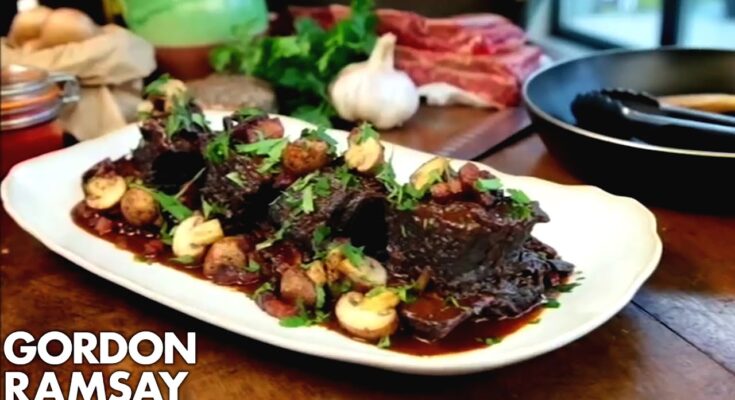Best Short Rib Recipe: Short ribs are one of those dishes that scream comfort food—rich, flavorful, and incredibly satisfying. They come from the beef chuck or rib section, and when cooked slowly, they transform into fork-tender, succulent bites. These ribs are especially popular in various cuisines, from Korean BBQ to hearty French stews, and their versatility is a huge part of their appeal.
Why do food lovers and home cooks adore short ribs? Because they’re loaded with marbled fat and connective tissue, which breaks down during cooking to create an insanely rich and savory flavor. This isn’t your everyday steak or roast—it’s the kind of meal you serve when you want to wow people, but also feel like wrapping yourself in a cozy food hug. The best part? With the right recipe and patience, they’re surprisingly easy to make.
In this guide, we’ll walk through everything step-by-step—from picking the right cut, prepping, cooking, and pairing to serving. By the end, you’ll be a short rib pro ready to impress at your next dinner.
Ingredients You’ll Need
Great recipes start with great ingredients, and this one’s no exception. Here’s what you’ll need to make the most flavorful, fall-apart short ribs:
Essential Ingredients:
- 3 to 4 lbs beef short ribs (bone-in recommended)
- Salt and black pepper (to taste)
- 2 tablespoons olive oil
- 1 large onion, diced
- 2 carrots, peeled and chopped
- 2 celery stalks, chopped
- 4 garlic cloves, minced
- 2 tablespoons tomato paste
- 1 cup red wine (optional but recommended)
- 3 cups beef broth
- 2 sprigs fresh rosemary
- 2 sprigs thyme
- 2 bay leaves
Recommended Additions or Swaps:
- Add mushrooms for an earthier profile
- Swap red wine for balsamic vinegar or more broth
- Use shallots instead of onions for a sweeter taste
- Include Worcestershire sauce for umami
This ingredient list builds a deep flavor base—sweetness from the veggies, acidity from the wine, savory notes from the broth, and the herbs tying everything together. You’ll be shocked how much complexity this simple list delivers.
Choosing the Best Cut of Short Ribs
Now, not all short ribs are created equal. The success of your dish starts with selecting the right cut.
Bone-In vs. Boneless:
- Bone-In Short Ribs: These are ideal for flavor and presentation. The bones add depth to the broth and help the meat retain moisture.
- Boneless Short Ribs: Easier to eat, but can dry out if overcooked. They’re great if you’re short on time or want a neater final dish.
If you’re shopping, ask your butcher for “English cut” short ribs—thick, meaty pieces with one bone running through them. Avoid pieces with too much fat or connective tissue unless you’re braising for a very long time.
How to Pick Quality Meat:
- Look for bright red color and visible marbling.
- Avoid pieces that look grayish or overly fatty.
- Grass-fed beef typically offers deeper flavor, but it can be leaner—balance is key.
Prepping the Short Ribs
The prep stage sets the tone for everything that follows. A little effort here makes a huge difference in flavor and texture.
Trimming and Seasoning:
First, trim any excess fat from the ribs—but don’t go overboard. That marbled fat is what makes the meat juicy. Pat them dry with a paper towel (this helps with searing), then generously season with salt and pepper. You want a nice crust to form when searing.
Marinating Tips:
While not essential, marinating the ribs in red wine, garlic, and herbs overnight can infuse deeper flavor. If you’re short on time, even an hour helps. Always marinate in the fridge, and let them come to room temperature before cooking.
Remember, seasoning is more than just salt—think about balance. Pepper adds heat, wine brings acidity, and garlic deepens the savory element.
Step-by-Step Cooking Instructions
Let’s get to the good part—the actual cooking. Follow this process and you’ll end up with a masterpiece on your plate.
Step 1: Searing the Short Ribs
Heat olive oil in a heavy-bottomed Dutch oven over medium-high heat. Once hot, sear the ribs in batches. Don’t overcrowd the pan. Brown each side (about 2–3 minutes per side) until a deep, golden crust forms.
Why sear? It locks in juices and builds a flavorful base for the sauce. Don’t rush this—color equals flavor.
Step 2: Building the Flavor Base
Once the ribs are seared, remove and set them aside. In the same pot, add the onion, carrots, and celery. Cook until soft, about 5 minutes. Add garlic and cook another minute. Stir in tomato paste and cook until it darkens—this adds sweetness and umami.
Deglaze the pan with red wine, scraping up the brown bits. Let it reduce by half, then add beef broth, herbs, and the seared ribs back into the pot.
Step 3: Braising the Ribs
Cover the Dutch oven and transfer to a preheated 325°F oven. Let it cook low and slow for 2.5 to 3 hours. The meat should be fork-tender and nearly falling off the bone.
If you’re using a slow cooker, cook on low for 8 hours. In an Instant Pot, use the “Meat/Stew” function and cook for 45 minutes.
Step 4: Resting and Serving
Once done, let the ribs rest for 15 minutes. Skim off excess fat from the surface of the sauce, then reduce it on the stove for a thicker consistency if needed.
Serve the ribs over mashed potatoes, creamy polenta, or buttered noodles, spooning the sauce over everything.
Best Cooking Methods for Short Ribs
Choosing the right cooking method can make or break your short ribs. The goal? Low and slow. Here’s how to choose between your options based on time, equipment, and taste.
Oven-Braised (The Classic Way)
This is the go-to for many home cooks and chefs. Why? Because the even heat from the oven mimics traditional braising perfectly. After searing and building your flavor base, you place the covered Dutch oven in a 325°F oven for 2.5 to 3 hours. This method yields the richest flavor and most tender meat. The dry heat of the oven also helps slightly reduce the sauce as it cooks, intensifying the flavor.
Pros:
- Best texture and depth of flavor
- Consistent, even heat
Cons:
- Requires monitoring and longer cooking time
Slow Cooker Version
For a more hands-off approach, the slow cooker is your best friend. After searing and building your base, transfer everything into the slow cooker. Set it on low for 8 hours or high for 4-5 hours.
Pros:
- No-fuss, set-it-and-forget-it
- Ideal for busy days
Cons:
- Sauce may need to be reduced on the stove after cooking
Instant Pot Option
Need short ribs in a hurry? The Instant Pot delivers all the flavor of a slow braise in a fraction of the time. Use the sauté function to sear, deglaze with wine, then pressure cook on “Meat/Stew” for 45 minutes. Let the pressure release naturally for 15 minutes before serving.
Pros:
- Quickest method
- Still results in tender meat
Cons:
- Less caramelization and slightly thinner sauce
Side Dishes That Pair Perfectly
Short ribs are bold and rich, so the best sides are those that balance and complement the flavors.
1. Creamy Mashed Potatoes
This is a no-brainer. The silky smooth texture of mashed potatoes soaks up the savory short rib sauce beautifully. Add a touch of roasted garlic or chives for extra depth.
2. Polenta or Rice
Polenta is an underrated gem. Its creaminess matches the ribs’ richness, especially when infused with butter and cheese. Basmati or jasmine rice works great too, especially if you’re doing a more Asian-style short rib.
3. Roasted Vegetables
Roasted carrots, Brussels sprouts, or asparagus bring balance to the richness of the dish. Their slight sweetness and caramelization cut through the heavy sauce.
4. Crusty Bread
Don’t let that sauce go to waste. A slice of rustic sourdough or French bread can be the perfect mop.
Tips for Making the Best Short Ribs
Making short ribs is pretty foolproof if you follow the basics, but these pro tips will elevate your dish from great to unforgettable.
Use Bone-In Ribs
They add more flavor to the braising liquid and help keep the meat moist.
Don’t Skip the Sear
That browned crust is where much of the flavor comes from. Use high heat and patience—let them sear undisturbed.
Deglaze Thoroughly
Use wine or broth to scrape every last bit off the pan after searing. That’s liquid gold for flavor.
Let Them Rest
Once they’re out of the oven or slow cooker, give the ribs 10–15 minutes to rest. This redistributes juices and ensures perfect tenderness.
Adjust the Sauce
If the sauce is too thin, simmer it on the stovetop until reduced. If it’s too thick, add a splash of broth. Always taste and adjust seasoning at the end.
Don’t Overcrowd the Pan
Whether you’re searing or slow cooking, space is key. Crowding traps steam and prevents browning.
Storing and Reheating Leftovers
One of the best things about short ribs? They taste even better the next day. Here’s how to keep them delicious:
Storing:
- Allow the short ribs to cool completely.
- Store in an airtight container with the sauce.
- Keep in the fridge for up to 4 days or freeze for up to 3 months.
Reheating:
- Stovetop: Reheat gently over low heat, covered, until warmed through.
- Oven: Place in a covered dish at 300°F for 25–30 minutes.
- Microwave: Use in a pinch, but heat in 1-minute intervals to avoid drying.
To freshen up leftovers, add a splash of broth or a pat of butter to revive the sauce.
FAQs about Short Rib Recipe
1. What’s the best wine for braising short ribs?
Use a full-bodied red like Cabernet Sauvignon, Merlot, or Syrah. Avoid sweet wines or anything too light-bodied. The wine should be drinkable—if you wouldn’t sip it, don’t cook with it.
2. Can I make short ribs ahead of time?
Absolutely. In fact, they often taste better the next day. Just refrigerate and reheat gently before serving.
3. What’s the ideal cooking time?
It varies by method, but in the oven: 2.5 to 3 hours at 325°F. Slow cooker: 8 hours on low. Instant Pot: 45 minutes with a natural release.
4. How do I make them more tender?
Low and slow is the secret. Don’t rush the process. Also, make sure there’s enough liquid and that the ribs are fully submerged during cooking.
5. Can I use frozen ribs?
Yes, but thaw them fully in the fridge before cooking. This ensures even searing and braising.
Final Thoughts
Short ribs are more than just a dish—they’re an experience. They bring comfort, warmth, and a bit of gourmet luxury to your table. Whether you’re cooking for family, entertaining guests, or just treating yourself, mastering this recipe guarantees you’ll leave a lasting impression.
The key lies in patience and quality ingredients. Low and slow cooking, thoughtful seasoning, and a bit of love will reward you with a dish that tastes like it took all day (because it probably did!). Don’t be surprised if your guests are begging for the recipe before they even finish their plate.
Now, it’s your turn—grab those ribs, fire up the Dutch oven, and get cooking.



